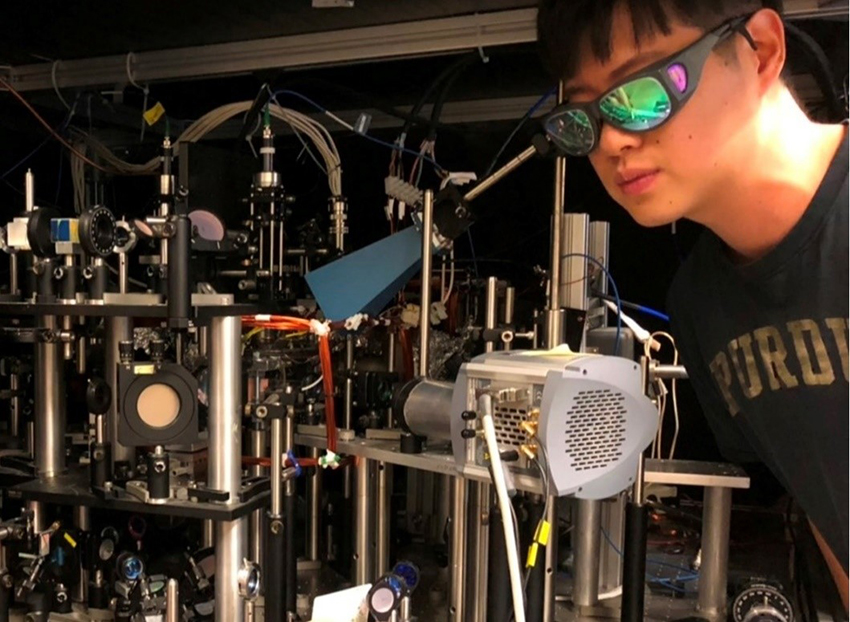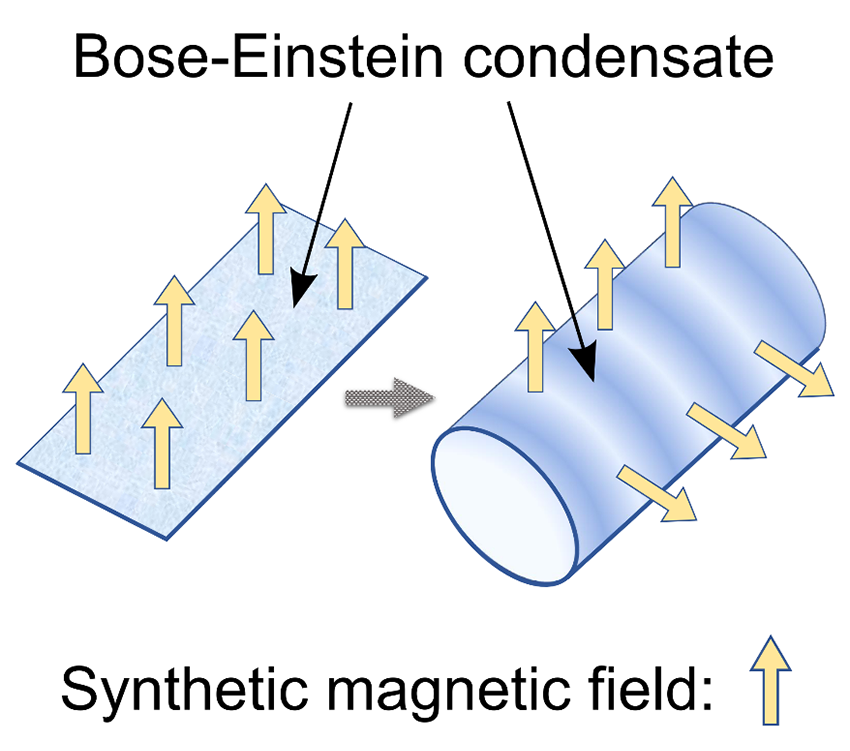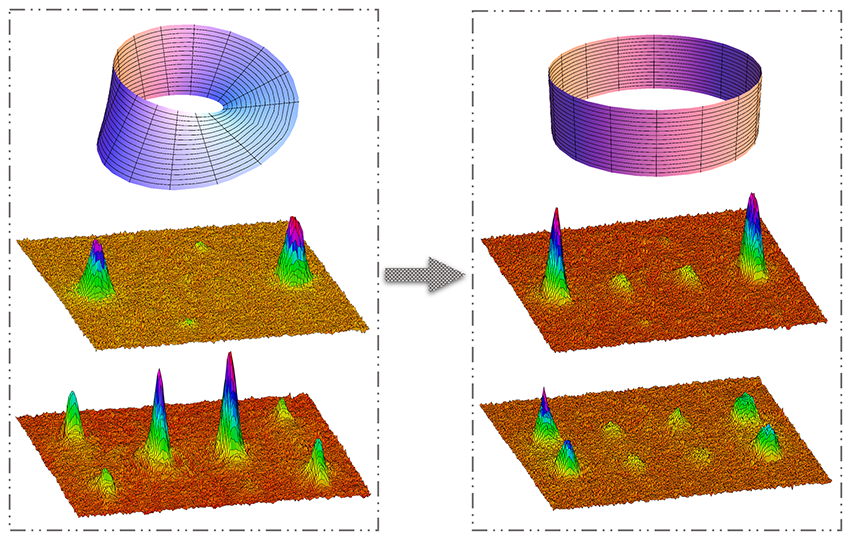Physicists create quantum matter in curved space
2022-02-14

Chuan-Hsun Li, post-doc working in the Quantum Matter and Devices Lab directed by Professor Yong Chen. Photo provided by Chuan-Hsun Li.
The discovery of the quantum Hall effect, with quantized conductance, has paved the way to the discoveries of various topological quantum matter. This effect occurring in two-dimensional electronic systems or materials is exceptionally reliable and has ignited scientific interest for well over forty years. The process typically used a planar “Hall device”, that today can be simply made of a two-dimensional material such as graphene (a single layer of graphite), subject to magnetic fields. Physicists have high hopes that the quantum Hall effect can be used in applications such as highly robust devices and quantum information processing. It can also provide an unprecedented standard for metrological applications.
Researchers at Purdue University have taken the Hall effect full circle… bending the typical flat surface into a cylinder. They have experimentally created synthetic Hall cylinders and found that they resulted in new topological phenomena that are absent in the flat Hall strip counterpart. This team recently published their findings in PRX Quantum: “Bose-Einstein Condensate on a Synthetic Topological Hall Cylinder."
This experiment was led by Chuan-Hsun Li, a post-doctoral researcher working in the Quantum Matter and Devices Lab of Purdue professor Yong P. Chen (Karl Lark-Horovitz Professor of Physics and Astronomy and Professor of Electrical and Computer Engineering and Director of Purdue Quantum Science and Engineering Institute), with contributions also from graduate students Shih-Wen Feng and David B. Blasing in Chen’s lab. Besides Li, Feng, Blasing and Chen, other co-authors of the paper include fellow Purdue colleagues and theoretical physicists Qi Zhou (associate professor of Physics and Astronomy), and two postdocs in Zhou’s group, Yangqian Yan and Sayan Choudhury. Zhou’s theory team had previously proposed the synthetic Hall cylinder in an earlier publication [Phys. Rev. Lett. 123, 260405 (2019)], and closely collaborated with Chen’s lab in the current experiment.
“The Hall cylinder we created is a synthetic quantum matter that presents an insightful example demonstrating the importance of spaces’ geometry in novel topological quantum phenomena and may provide practical insights into synthesizing quantum matter in unconventional spaces,” says Li. “Such a direction has been of great interest yet largely unexplored experimentally due to experimental challenges. The quantum system we created could also serve as a ‘quantum simulator’ for various quantum phenomena that could generate useful insights to understand or design new quantum materials.”

On the left is a typical Hall strip. On the right is the Hall cylinder. The yellow arrows represent the direction of synthetic magnetic fields. A Bose-Einstein condensate on the Hall cylinder automatically develops intriguing topological features that are absent in the Hall strip.

This figure shows select experimental images that reveal the quantum states of a Bose-Einstein condensate on a Hall cylinder before and after a topological transition from a Möbius strip to a regular strip in momentum space. Graphics in this article provided by Chuan-Hsun Li and Yong P. Chen.
These magnetic fields result from a quantum mechanical phase carefully engineered by the team. They determined that, once they had experimentally fixed such a phase, an identical magnetic field effectively always perpendicular to the surfaces of the strip or cylinder (in the synthetic space) emerges even when the size changes or the shape slightly deforms.
“The Hall cylinder we created is a synthetic one in the sense that the long axis is a real spatial dimension while the curved axis is a synthetic dimension composed of atoms’ internal states,” says Li. “The reason why we created a synthetic one is that such a setup allows us to create the radial magnetic fields threading the synthetic cylinder, which are challenging if not impossible to realize for a real cylinder yet a crucial ingredient for observing our results. In addition, if we use similar experimental parameters, the cylinder can always be produced in a precise way and the results are quite robust (subject to common experimental fluctuations such as the number of atoms not related to the cylinder itself). One advantage of creating synthetic matter is its reproducibility, which could be a critical issue that manufacturing real materials may suffer from.”
Currently, creating a real Hall cylinder would be extremely challenging so the team used a quantum simulator, a highly tunable quantum system that can simulate and explore phenomena challenging to control and study in other quantum systems. What the team has created is a quantum simulator that makes atoms mimic electrons in materials and concomitantly live in an unconventional space. This quantum simulator can create a synthetic Hall cylinder that is well-controllable and relatively easy for us to study.
“Electrons on curved spaces such as tori with magnetic fields have been previously studied theoretically as an important platform for topological quantum states, with potential application for robust, fault-tolerant topological quantum computing,” says Zhou. “Such states have been difficult to realize experimentally. The cold atoms based ‘quantum simulator’ on such synthetic curved spaces could potentially offer a pathway to experimentally realize and study such states in a cleaner and more controllable way compared to electrons in solids”.
The team plans to continue their work with Hall cylinders. Their discovery could lead to many phenomena to be explored such as topological phase transitions induced by the axial magnetic field or fractional quantum Hall-like states on the cylinder.
“We are interested in realizing quantum matter on other synthetic curved surfaces such as a Hall torus,” says Chen. “It will be very exciting to explore novel quantum phenomena (such as unconventional superfluids) emerging in such unconventional spaces that have been impossible to realize in solid-state materials. Realizing and studying Hall cylinders are one inspiring step toward an emerging direction that has been of great interest yet largely unexplored experimentally -- exploring quantum matter in different types of unconventional spaces. This is an exciting direction because materials used in current technologies are typically in flat spaces. If novel material properties can arise in unconventional spaces, we may find numerous applications difficult to access with materials in flat spaces but possible with materials in unconventional spaces”.
Writer: Cheryl Pierce
Contributors: Dr. Chuan-Hsun Li, Prof. Qi Zhou, Prof. Yong Chen
Photos and graphics provided by Li and Chen